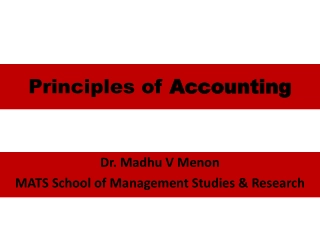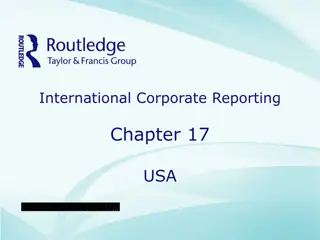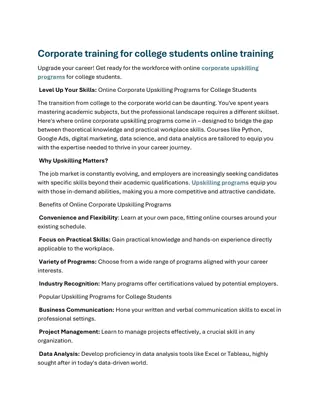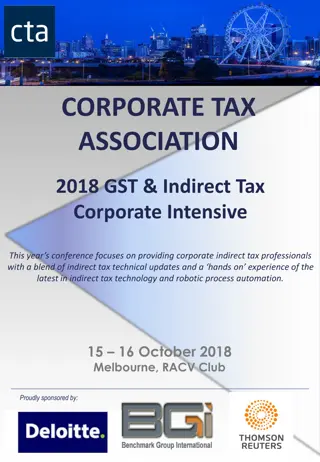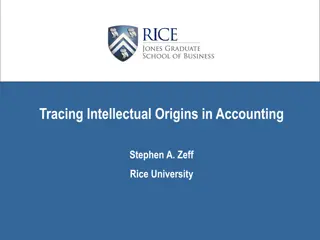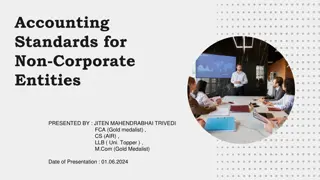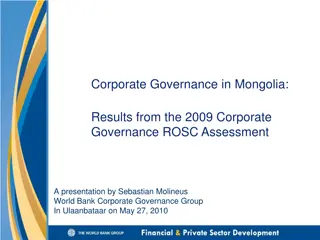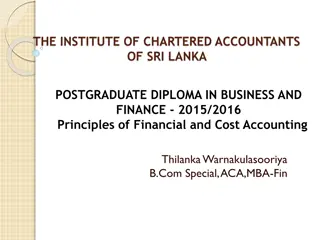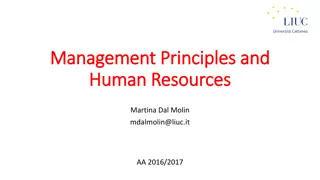
The Features and Kinds of Companies in Business
Learn about the essential features of a company, including registration, legal personality, contractual capacity, management, and perpetual existence. Explore different kinds of companies based on liability, such as limited, guarantee, and unlimited companies.
Download Presentation

Please find below an Image/Link to download the presentation.
The content on the website is provided AS IS for your information and personal use only. It may not be sold, licensed, or shared on other websites without obtaining consent from the author. If you encounter any issues during the download, it is possible that the publisher has removed the file from their server.
You are allowed to download the files provided on this website for personal or commercial use, subject to the condition that they are used lawfully. All files are the property of their respective owners.
The content on the website is provided AS IS for your information and personal use only. It may not be sold, licensed, or shared on other websites without obtaining consent from the author.
E N D
Presentation Transcript
UNIT UNIT- -1 ACCOUNTING FOR SHARE 1 ACCOUNTING FOR SHARE CAPITAL CAPITAL
MEANING OF COMPANY Companyisavoluntaryassociationofpersonsformedforthepurpose ofdoingbusinesshavingadistinctnameandlimitedliability. It is a juristic person having a separate legal entity distinct from the members who constitute it, capable of rights and duties of its ownand endowedwiththepotentialofperpetualsuccession. The Companies Act, 1956, states that 'company' includes company formed and registered under the Act or an existing company i.e. a company formed or registered under any of the previous company laws.
FEATURES OF A COMPANY 1.Registration A company comes into existence only after registration under the Companies Act. But a Statutory Corporation is formed and commencebusinessasnotifiedorstatedintheActandaspassedin Legislature.Incaseofpartnership,registrationisnotcompulsory. 2.VoluntaryAssociation A company is an association of many persons on a voluntary basis. Therefore a company is formed by the choice and consent of the members. 3.LegalPersonality A company is regarded by law as a single person. It has a legal personality. This rule applies even in the case of One-man Company.
4. Contractual Capacity A shareholder of a company, in its individual capacity, cannot bind the company in any way. The shareholder of a company can enter into contract with the company and can be an employee of the company. 5. Management A company is managed by the Board of Directors, whole time Directors, Managing Directors or Manager. These persons are selected in the manner provided by the Act and the Articles of Association of the company. A shareholder, as such, cannot participate in the management. 6. Permanent Existence The company has perpetual succession. The death or insolvency of a shareholder does not affect its existence. A company comes into end only when it is liquidated according to provision of the Companies Act.
KINDS OF COMPANIES Form the point of view of liability there are three kinds of Companies (1) Limited Companies In case of such companies, the liability of each member is limited to the extent of a face value of shares held by him. Suppose A takes a share of Rs 10., he remains liable to the extent of that amount. As soon as that amount in paid, he is no more liable. (2) Guarantee Companies The liability of the member of such companies is limited to the amount he has undertaken to contribute to the assets of the company in the event of its wound up. This guaranteed amount is limited to fixed sum which is specified in the memorandum. (3) Unlimited Companies They are nothing but large partnership registered under the Companies Act and the members just like partners have unlimited liability and both share contribution as well as their property are at stake when the company is to be wound up. Such companies are rare these days.
FromthepointofviewofPublicinvestmentcompaniesmaybeoftwokinds:FromthepointofviewofPublicinvestmentcompaniesmaybeoftwokinds: (1)PrivateCompanies: A private company means a company which by its articles (a) restricts the right to transfer its shares, if any (b) limits the number of its members to fifty excluding past or present employees of the company who are also members of the company. (c) Prohibits any invitation to the public to subscribe foranysharesinourdebenturesofthecompany. (2)PublicCompanies: Public companiesarethose companies whicharenot privatecompanies.All thethreeABOVE restrictionsarenotimposedonsuchcompanies.
SHARE CAPITAL ISSUE AND FORFEITURE OF SHARES 1. AUTHORISED CAPITAL is also referred to, at times, as registered capital. This is the total of the share capital which a limited company is allowed (authorized) to issue to its shareholders. It presents the upper boundary for the actually issued share capital (hence also 'nominal capital'). 2. Issued Share Capital is the total of the share capital issued to shareholders. This may be less than the authorized capital. 3. Subscribed Capital is the portion of the issued capital, which has been subscribed by all the investors including the public. This may be less than the issued share capital as there may be capital for which no applications have been received yet ('unsubscribed capital'). 4. Called up Share Capital is the total amount of issued capital for which the shareholders are required to pay. This may be less than the subscribed capital as the company may ask shareholders to pay by installments. 5. Paid up Share Capital is the amount of share capital paid by the shareholders. This may be less than the called up capital .
JOURNAL ENTRIES FOR ISSUE OF SHARES (1) On receipt of application money Bank Account Dr To Share Application A/c (Being the application money on....shares..@ Rs.pershare) (2) On allotment of shares First of all application money on allotted shares is transferred to shares capital account Share Application Account Dr To Share Capital A/C (Being the application money transferred to Share Capital Account) (b) Those applicants who could not be allotted any share, their application money will be returned. Share Application Account Dr To Bank Account (Being the application money of shares returned)
Issue of shares at premium If a company issues its shares at a price more than its face value, the shares are said to have been issued at Premium. The difference between the issue price and face value or nominal value is called Premium . If a share of Rs 10 is issued at Rs 12, it is said to have been issued at a premium of Rs 2 per share. The money received as premium is transferred to Securities Premium A/c. The Companies Act has laid down certain restrictions on the utilization of the amount of premium. According to Section 78 of this Act, the amount of premium can be utilized for : (i) Issuing fully-paid bonus shares; (ii) Writing off preliminary expenses, discount on issue of shares, underwriting commission or expenses on issue; (iii) Paying premium on redemption of Preference shares or Debentures. (iv) For purchase of its own shares.
Accounting Treatment of premium on Issue of Shares Following is the accounting treatment of Premium on issue of shares : (a) Securities premium collected with share Application money : If the Securities premium is collected on application and the company has taken decision about the allotment of shares, the following journal entry is made : Share Application A/c. Dr To Securities Premium A/c (The amount of Securities premium received on application of the allotted shares is transferred to Securities Premium A/c) (b) Premium collected with Allotment money or Calls. If the company decides to demand the premium with share Allotment or and share call money, the journal entry made is: Share Allotment A/c Dr Or/and Share Call A/c Dr To Securities Premium A/c (Adjustment of share premium due on shares @Rs .per share.)
ISSUE OF SHARES AT DISCOUNT Whentheissuepriceofshareislessthanthefacevalue,sharesaresaid tohavebeenissuedatdiscount.Forexampleifacompanyissuesitsshares ofRs100eachatRs.90each,thesharesaresaidtobeissuedatdiscount. TheamountofdiscountisRs10pershare(i.e.Rs100 Rs90).Discount onsharesisalosstothecompany. Section79ofCompaniesAct1956haslaiddowncertainconditionssubject towhichacompanycanissueitssharesatadiscount.Theseconditionsare asfollows: (i)Atleastoneyearmusthaveelapsedfromthedateofcommencement ofbusiness; (ii)Suchsharesareofthesameclassashadalreadybeenissued; (iii)Thecompanyhassanctionedsuchissuebypassingaresolutionin itsGeneralmeetingandtheapprovalofthecourtisobtained. (iv)Discountshouldnotbemorethan10%ofthefacevalueofthe shareandifthecompanywantstogivediscountmorethan10%, itwillhavetoobtainthesanctionoftheCentralGovernment.
FULL, UNDER AND OVER SUBSCRIPTION A company decides to issue number of shares to raise capital. It invites public to buy these shares. Now there may be three situations : 1.Full Subscription Company may receive applications equal to the number of shares company has offered to people. It is called full subscription. In case of full subscription the journal entries will be made as follows : (a) On receipt of application money Bank A/c Dr To Share Application A/c (Application money received for ......... shares) (b) On allotment of shares Share Application A/c Dr To Share Capital A/c (Application money of shares transferred to capital A/c on their allotment)
II. The company does not receive application equal to the number of shares offered for subscription, there may be two situations : (i) under subscription (ii) over subscription (i) Under subscription The issue is said to have been under subscribed when the company receives applications for less number of shares than offered to the public for subscription. In this case company is not to face any problem regarding allotment since every applicant will be allotted all the shares applied for. But the company can proceed with allotment provided the subscription for shares is at least equal to the minimum required number of shares termed as minimum subscription. (ii) Over Subscription When company receives applications for more number of shares than the number of shares offered to the public for subscription it is a case of over subscription. A company cannot allot more shares than what it has offered. In case of over subscription, company has the following options
If the application money received on partially accepted applications is more thantheamountrequiredforadjustmenttowardsallotmentmoney,the excessmoneyisrefunded.However,iftheArticlesofthecompany so authorize,thedirectorsmayretaintheexcessmoneyascallsinadvance to beadjustedagainstthecall/callsfallingduelateron. theentryismade: ShareApplicationA/cDr ToCall-in-advanceA/c (The adjustment of excess share application money retained as call-in advanceinrespectof ...shares).
Option I 1.Rejection of Excess Applications and Money Returned The company may reject the applications for shares in excess of the shares offered for issue and a letter of rejection is sent to such applicants. In this case the application money received from these applicants is refunded to them in full. The journal entry made is as follows: Share Application A/c Dr To Bank A/c (Application money on shares refunded to the applicants) (ii) Excess application money adjusted towards sums due on allotment. Journal entry made is : Shares Application A/c Dr To Share Allotment A/c (Excess application money adjusted towards sums due on allotment)
If the application money received on partially accepted applications is more than the amount required for adjustment towards allotment money, the excess money is refunded. However, if the Articles of the company so authorize, the directors may retain the excess money as calls in advance to be adjusted against the call/calls falling due later on. the entry is made : Share Application A/c Dr To Call-in-advance A/c (The adjustment of excess share application money retained as call-in advance in respect of ... shares).
Option II Partial acceptance of Applications. In some cases the company accepts the applications for subscription partially. It means that the company does not allot the full number of shares applied for. For example if an applicant has applied for 5000 shares and is allotted only 2000 shares, then the applications is said to have been partially accepted. The company may evolve some formula of accepting applications partially or making proportionate allotment/ the Pro rata allotment which means that the applicants are allotted shares proportionately. In such a case the company adjusts the excess share money received on application towards share allotment money due on partially accepted applications. The journal entry recording the adjustment of application money towards share allotment money, is as under : Share Application A/c Dr To Share Allotment A/c (Share application money transferred to Share Allotment Account in respect of ... shares)
CALLS IN ADVANCE AND CALLS IN ARREARS If a shareholder pays any amount to company before it is demanded, it is called Call-in-Advance. This amount is put in a separate account known as Calls-in-Advance A/c. This amount is not shown as capital of the company, till such time the company makes a demand from all the shareholders. Call-in-Advance A/c is shown on the liabilities side of the Balance Sheet. For example if a company issued shares of Rs 10 on which it has already called Rs 5. Against the uncalled portion of Rs 5 per share the company makes a call Rs 3 per share, the entry for call money due will be made only for Rs 3 per share. Now suppose a shareholder pays Rs 5 per share including the uncalled amount of Rs 2 per share along with the call money, it means he has paid Rs 2 per share in advance, which will be credited to calls in Advance A/c. The company is required to pay interest on this amount @ 6% till the date of its appropriation.
Accounting treatment Following journal entry is made for calls-in-advance. Bank A/c Dr To Calls-in-Advance A/c (Calls in advance received on .shares @ Rs .per share) Appropriation of calls-in-Advance A/c say in the final call Journal entry will be : Calls-in-Advance A/c Dr To Share Final call A/c (Calls in advance amount adjusted) For interest given on Calls-in-Advance Journal entry will be Interest on calls-in-Advance A/c Dr To Bank A/c (Interest paid on the amount of Call-in-Advance)
Calls in arrears When the company sends notice to the shareholders to pay allotment and call money, it has to be paid by them within the specified time period. If it is not paid by any one or more of the shareholders, the unpaid amount becomes arrears due from them. Such arrears are transferred to an account termed as Calls-in-Arrears A/c. The company is authorized to charge interest on calls-in-Arrears @ 5% p.a. for the intervening period Accounting Treatment The following journal entry is made to record Calls-in-Arrears: Calls-in-Arrears A/c Dr To Share Allotment/Call A/c (Share allotment/ Call money not received on . shares) When the unpaid balance is received later on the following journal entry is made: Bank A/c Dr To Calls in Arrears A/c (Amount due on allotment/ call remaining unpaid now received on shares.)
FORFEITURE OF SHARES If a shareholder fails to pay the due amount of allotment or any call on shares issued by the company, the Board of directors may decide to cancel his/her membership of the company. With the cancellation, the defaulting shareholder also loses the amount paid by him/her on such shares. Thus, when a shareholder is deprived of his/her membership due to non payment of calls, it is known as forfeiture of shares. 1. Forfeiture of shares issued at Par When shares issued at par are forfeited the accounting treatment will be as follows: (i) Debit Share Capital Account with amount called up (whether received or not) per share up to the time of forfeiture. (ii) Credit Share Forfeited A/c. with the amount received up to the time of forfeiture. (iii) Credit Unpaid Calls A/c with the amount due on forfeited shares. The
FORFEITURE OF SHARES ISSUED AT PREMIUM AND AT DISCOUNT In case shares are issued at premium and thereafter forfeited there can be two situations : Premium on shares has been received prior to the forfeiture. Amount of premium on shares has not been received and it still stands credited to the Securities Premium A/c. 1. Premium money has been received prior to the forfeiture If the amount of premium on shares forfeited has been received by the company prior to the forfeiture, securities Premium A/c will not affected. In this case the journal entry of forfeiture of shares will be similar to the entry made as if the shares had been issued at par. The journal entry will be : Share Capital A/c Dr To Share forfeited A/c To Unpaid Calls A/c./Calls in arrears A/c (forfeiture of share issued at premium)
2. Premium on shares has not been received and stands credited to Securities Premium A/c as due but not paid. When a share is forfeited on which the amount of premium has been made due but has not been received, either wholly or partially, the Securities Premium A/c will be cancelled. At the time of making due, Securities Premium A/c will be credited. The journal entry will be as follows: Share Capital A/c Dr Securities Premium A/c Dr To Share Forfeited A/c To Unpaid call A/c. (Forfeiture of shares originally issued at premium due to non payment of dues).
Forfeiture of shares issued at discount Discount on issue of shares is a loss to the company. When shares issued at a discount are forfeited for non payment of dues, the discount allowed on such shares is written back. At the time of issue of shares, Discount on issue of Shares A/c is debited and when forfeited, this account is credited to cancel the discount allowed on such shares. In this case the following journal entry is made : Share Capital A/c Dr. To Share Forfeited A/c To Discount on Issue of Shares A/c To Unpaid call A/c (Forfeiture of shares originally issued at discount for non payment of dues).
REISSUE OF FORFEITED SHARES Forfeited shares may be reissued by the company directors for any amount bit if such shares are issued at a discount then the amount of discount should not exceed the actual amount received on forfeited shares plus original discount on reissued shares, if any. The following journal entry will be passed : Bank a/c Dr. ( amount received) Discount on issue of shares a/c Dr.(with original rate of discount if issued at dis) Share forfeited a/c(loss on issue) To share capital a/c( with face value of shares ) To securities premium a/c(if shares are reissued at premium) After the reissue if there is no balance in shares forfeited account then there will be no capital profit. But where there is profit on the reissue of forfeited shares , such a profit is treated as a capital profit and balance or amount relating to shares reissued will be transferred to capital reserve by following entry ; Share Forfeited a/c To capital reserve a/c
UNIT UNIT- -II: issue and redemption II: issue and redemption of debentures of debentures
Definition of debenture It includes debenture stock , bonds , and any other securities of a company whetherconstituting achargeontheassetsofacompanyor not Features of Debentures Itisadocumentwhichacknowledgesthedebtofcompany Itcarriesinterestatfixedrate Adebentureissecuredbychargeontheassetsofcompany Theydonotenjoythevotingrights
Nature of debenture It is a part of borrowed funds They are the creditors of the company Debenture holders gets interest even if there are losses They are redeemed on due date Debenture holders don t enjoy voting rights They can be converted into equity shares There are no legal restrictions on purchase of its own debentures
Types of debentures Simple or unsecured debentures- These are those debentures which have no security Secured debentures- These are those debentures which are secured against the particular assets of the company Redeemable debenture- These are those debentures that will be repaid by the company at the end of specified period during the existence of company Irredeemable debenture- They are not to be repaid during the lifetime of company Convertible debenture- Debentures which gets converted into equity shares Non convertible debenture-they cannot get converted into equity shares Registered debentures- These are those dentures in which detail of debenture holders are registered in the register of company Bearer debentures- These are those debentures which can be transferred by way of delivery and company does not keep any record of the debenture holder
Redemption of Debenture Discharge of liability on account earlier issued by the company redemptionofdebenture of debentures is called as Methods of Redemption of debentures Redemption out of Profits Redemption out of capital Redemption by conversion Redemption of debentures by purchasing own debentures in the open market
Sources of redemption of debenture Redemption out of fresh capital Redemption by conversion Redemption out of sale proceed Redemption out of Existing Capital Redemption out of profits
Meaning of Goodwill Meaning of Goodwill It is a good name or reputation earned by a firm. It is an intangible asset. It is the value of business over and above the value of its assets. It is the difference between the purchase price and the value of net assets. It has a positive impact on the future turnover and profits of the business. 34
Factors Affecting Valuation of Goodwill Factors Affecting Valuation of Goodwill 1. Good Public Relation 2. Regular Customers 3. Quality Product in Reasonable Price 4. Management Skills 5. Location of Business 6. Good Relation with Suppliers 7. Employees 35
Methods of Valuation of Goodwill Methods of Valuation of Goodwill 1. Simple Average Profit Method 2. Super Profit Method 3. Weighted Average Method 4. Capitalization Method a. Capitalization of Average Profit Method b. Capitalization of Super Profit Method 36
1. Simple Average Profit Method Simple Average Profit Method Goodwill = Average Profit * Number of year of purchase Average Profit = Total Profit / Number of Years Number of years of purchase means the number of year for which the firms is likely to earn the same amount of profit. Things to consider before calculating the average profits :- 1. Any abnormal profit should be deducted from the net profits of that year. 2. Any abnormal loss should be added back to the net profits of that year. 3. Non-operating incomes e.g. income from investments should be deducted from the net profits of that year.
2. Super Profits Method . Super Profits Method Goodwill is calculated on the basis of Super Profit i.e. the excess of actual profits over the average profits. Formula:- Goodwill = Super Profit * No. of years purchase Super Profit = Average Profits - Normal Profits Normal Profits = Capital Employed * Normal Rate of Return / 100 38
3. Weighted Average Profit method 3. Weighted Average Profit method This method is the modified version of the simple average profit method. In this method, each year s adjusted profits are multiplied with the respective number of weights in order to calculate the total product. The total of products is then divided by the total of weights to calculate the weighted average profits. Thereafter, the weighted average profits are multiplied by the number of years of purchase. Formula : Weighted Average Profits = Total Products o Profits / Total of Weights Goodwill = Weighted Average Profits * No. of years of purchase Prepared by: Dr. Kawale Pushpalata 39
4. Capitalization of Profit Method . Capitalization of Profit Method a. Capitalization of Average Profit Method = Average Profit / NRR * 100 b. Capitalization of Super Profit Method = Super Profit / NRR * 100 Prepared by: Dr. Kawale Pushpalata 40
Valuation of shares Valuation of shares Need for valuation: 1. At the time of amalgamation. 2. When loan is granted on the security of shares. 3. When preference shares or debentures are converted into equity shares. 4. When equity shareholders are to be compensated on acquisition of their shares by the govt. under a scheme of nationalisation.
Factors affecting valuation of shares Factors affecting valuation of shares Nature of the business Demand and supply for shares Govt. policy Past performance of the company Growth prospectus of the company The management of the company The economic climate Accumulated reserves Prospects of bonus or rights issue Dividend declared etc.
Methods for valuation Methods for valuation Net assets basis (or intrinsic value) method Yield basis method Dual (or fair value) method
Net assets basis method Net assets basis method Net tangible assets basis (excluding goodwill) 1. Under this method, net tangible assets are estimated in order to value the shares. Net tangible assets = Assets Liabilities Assets are taken at their actual values (market values) and not at book values. Fictitious assets like preliminary expenses are excluded. All the liabilities (whether in books or not) are deducted. Non trading assets are also included in the assets. Amount payable to preference shareholders is also deducted. value of share = net tangible assets/no. of equity shares
2. Net assets (including goodwill) In this method, goodwill is included with other tangible assets for the valuation of shares. Goodwill is taken at its actual value which maybe equal to, more than or less than the book value. There maybe some value of goodwill even if it is not shown in the books.
Yield method Yield method Following steps are taken for calculating the value of shares under this method: 1. Calculation of average expected future profits (profit available for equity shareholders). 2. Calculation of expected return. Expected return= expected profits/equity share capital *100 3. Value of share= Expected rate/normal rate *paid up value of one share
Dual or fair value method It is simply a combination of the previous two methods. According to this method, Value of share= net asset method value + yield method value/2 For eg: Net asset method value: Rs. 10 Yield method value: Rs. 12 Fair value: Rs.10+Rs. 12/2 =Rs. 11
UNIT UNIT- -V: COMPANY FINAL V: COMPANY FINAL ACCOUNTS ACCOUNTS
COMPANIES ACT 2013 COMPANIES ACT 2013 1 Schedule III Format of balance sheet. Format of profit and loss Account.

